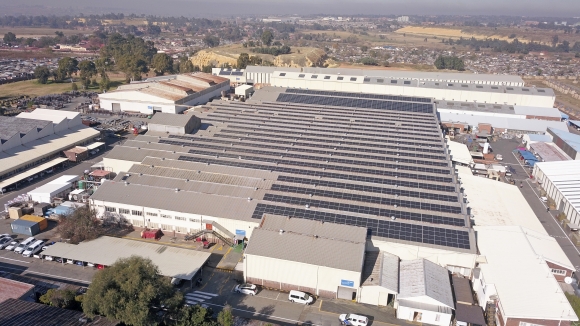ACTOM recently gave the go-ahead for the first solar power generation system to be installed at the group’s main factory complex at Knights, Germiston.
MV Switchgear is the largest consumer of power among the various manufacturing divisions at the Knights site and was therefore selected as the first division to be equipped with a solar generation system.
ACTOM plans to progressively introduce solar generation systems at other factories on the Knights site as well as at group factories and workshops situated elsewhere in Gauteng and around the country in due course.

The solar installation at MV Switchgear, which went into operation in July this year after installation and commissioning were completed in June, is a grid-tied PV solar system that is designed to generate around 1MW of power, which is approximately the division’s power consumption at peak load and about 50% of the peak load drawn by all the factories at the Knights site.
“We consequently expect the system to reduce the Knights site power consumption from the national grid by up to 50%, which represents a significant cost saving for us,” commented Rhett Kelly, MV Switchgear’s Design & Development Manager, who added that the reduction in power consumption from the grid can only be roughly estimated at this early stage, since the solar generation system has not yet been in operation for long enough for a more accurate figure to be determined.
“MV Switchgear’s energy consumption and thus electricity bill is expected to drop by up to 75%. This figure will naturally depend on the weather and the degree of operations carried out during the night hours when the solar system is unable to generate power,” he added.
The system comprises two identical 550kW grid-tied PV solar powered inverter installations, which have been installed at the major two transformer locations respectively in MV Switchgear’s network supplying power to various parts of its extensive factory, with the solar panels that are installed on the main factory roof being linked to the inverter stations located at these two transformer locations.
Each inverter station comprises five 110kW inverters, an inverter collector box and a data management system. “Each inverter system is tied into the low voltage electrical installation of its respective main distribution board. If the power generated at the inverter station exceeds the power demand at its respective location, any excess power generated is back-fed via the transformer into the Knights site 11kV ring network and can be used to supplement the power demands at other locations on the site, thus ensuring that no PV generated power goes unused,” said Rhett.
Johan Jordaan, MV Switchgear’s Technology Development Specialist, further explained: “The system operates without battery backup and therefore requires an AC (50Hz) mains supply to support the load when inconsistent or no power can be generated from the solar panels due to overcast conditions or at night. By definition, a grid-tied solar generation system without a battery storage system cannot operate in isolation, its aim and purpose being to reduce the energy consumed from the grid.”
For some time the division has been well-equipped with diesel-powered generators as an alternative source of 50Hz AC power to the mains supply from the grid, such as typically – and increasingly in recent times – is the case when load-shedding occurs.
“Here again, as with mains supply from the grid, our adoption of solar generated power provides us with the opportunity to reduce our dependence on expensive diesel power generation. We cannot do without it, but now, thanks to having brought solar generation into play, we require it less than previously and are able to achieve substantial energy cost savings as a result,” Johan stated.

